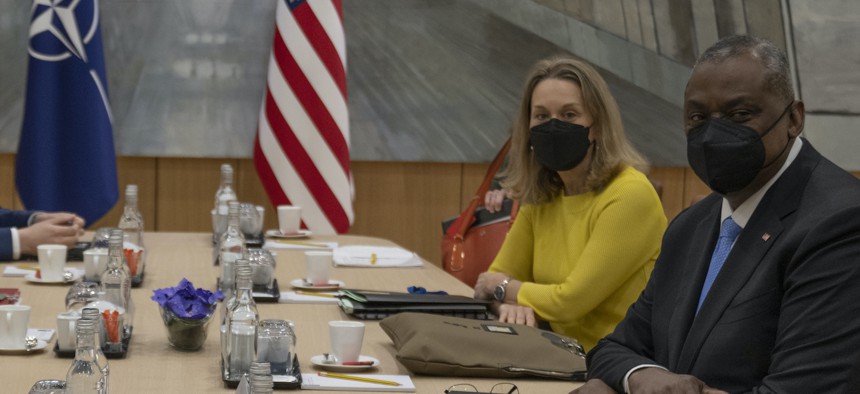
Amb. Julianne Smith, U.S. Permanent Representative to NATO, and Defense Secretary Lloyd Austin before defense ministerial meetings at NATO headquarters in Brussels, Belgium, Feb. 16, 2022. DoD / Chad J. McNeeley
NATO’s Next Strategic Concept Will Add China’s Threats, US Ambassador Says
The document is to be unveiled at next month’s summit, where Russia and potential members will also be on the agenda.
Even as a war rages in its own backyard, NATO will use its highly anticipated summit later this month to look beyond the concerns of the moment and address the threat posed by China for the first time in a major document, a top American official told reporters on Wednesday.
Much of the conversation at the upcoming summit in Madrid is still expected to focus on deterring Russia amid its invasion of Ukraine and considering the applications from Finland and Sweden to join the alliance. But the strategic concept to be unveiled at the summit must encompass the next decade, which will see threats from China and emerging technology such as cyber attacks, said Julianne Smith, the United States’ permanent representative to NATO.
“We are largely in agreement that Russia is the preeminent challenge, the primary threat that the NATO alliance is facing in this moment, and because of that, you’ll see a heavy emphasis on Russia right out of the gates at the top,” Smith said at an event hosted by the Defense Writers Group. “There is also an appreciation across NATO that this document is not intended to last for a week. This document…is supposed to last for 10 years.”
NATO’s current strategic concept was released in 2010, four years before Russia annexed Crimea and years before major cyber attacks were commonplace. The 36-page document does not mention China; it also says the alliance seeks “a true strategic partnership” and more cooperation with Russia.
The new, not-yet-finalized document set to be released in Spain will include the first mention of China in a NATO strategic concept, Smith said—though a statement released in June 2021 after an alliance summit in Brussels said that China’s “growing influence and international policies can present challenges that we need to address together as an alliance.” NATO leaders are also expected to address cooperation between Russia and China and how it affects the alliance, Smith said.
NATO members have been united in their condemnation of Russia’s invasion of Ukraine. The alliance itself has provided no military support to Ukraine, a non-member, but many member countries, including the United States, have shipped billions of dollars worth of arms to Kyiv in addition to money for humanitarian aid and economic recovery.
Besides the long view of the strategic concept, Smith said, NATO leaders might also release a communique or political declaration about the current threat posed by Russia and the war in Ukraine.
NATO, which includes countries in Europe plus the United States and Canada, is seeking to expand its relationships with governments outside the region, and has invited leaders from Australia, New Zealand, Japan, and South Korea to attend the summit in Madrid, Smith said.
Smith said there is no talk of an Indo-Pacific-focused council within NATO, but added that bringing in partners from the region can help share lessons about Chinese and Russian cyber attacks and disinformation campaigns.
“It’s been interesting for me to watch countries in the Asia-Pacific talk about hybrid threats on their side of the Pacific…from China. Then you pair that with an Estonian or a Lithuanian, and they talk about some of the challenges that they’re seeing from Russia,” she said.
One of the biggest questions to be addressed at the summit is how many troops or weapons NATO will position on its border with Russia in the medium and long term, Smith said. NATO ramped up its presence on its eastern front when the war in Ukraine began, but it’s not clear how long those troops will stay, or what the force posture will look like if the fighting ends.
There’s also the question of whether Finland and Sweden, which applied to join NATO last month, will be welcomed into the alliance by the summit in late June amid Turkish opposition because of the Nordic countries’ views on terrorism. NATO leader Jens Stoltenberg said Wednesday that he will meet in “in the coming days” in Brussels with senior officials from Turkey, Finland, and Sweden to discuss Turkish concerns.
“I’m confident that we will find a united way forward,” Stoltenberg said during a press conference at the State Department.




